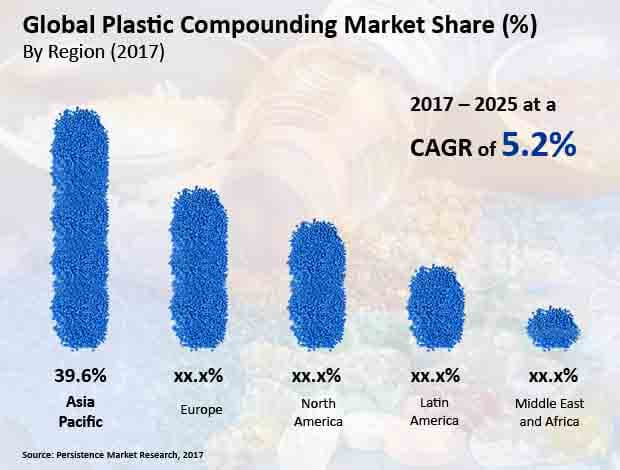Plastic Compounding Market Segmented By Polymer/Copolymers, Additives Product in Textiles, Packaging, Healthcare, Industrial Goods, Consumer Goods
Industry: Chemicals and Materials
Published Date: July-2017
Format: PPT*, PDF, EXCEL
Delivery Timelines: Contact Sales
Number of Pages: 222
Report ID: PMRREP16978
The global plastic compounding market is estimated to account for over US$ 420 Bn by the end of 2017 and registering a CAGR of 5.2% during the forecast period (2017–2025), is projected to reach a market value of about US$ 645 Bn by 2025 end.

Increasing plastics demand in construction, automotive and electrical & electronics sectors is expected to be a major factor driving global plastic compounding industry growth. Synthetic polymers such as PVC, PE, PC, PP, and PU have been traditionally used in various applications such as packaging, electronic components, automotive components, toys, furniture and construction materials.
Regulatory intervention to reduce gross vehicle weight to improve fuel efficiency and ultimately reduce carbon emissions has driven automotive OEMs to adopt plastics as the substitute to metals such as steel and aluminum for fabricating automotive components. With growing thermoplastic and thermosets demand in automotive component fabrication, plastic compounding is expected to gain prominence due to increasing quality and material specification requirements from automotive OEMs.
Plastics demand is increasing in the construction sector in floorings, insulation materials, storage tanks, performance safety windows, doors, pipes and cables. Growing residential and commercial projects in developing countries is boosting infrastructural development. Further, consumer awareness regarding attractive interiors is increasing the demand for these materials in interior designing. A booming construction industry is anticipated to complement the plastic compounding market during the forecast period. This industry will register significant growth in the end-user segment of the market.
Large investments in sectors such as water and sanitation management, irrigation, building & construction, power, transport, retail etc. are continuously being made. PVC and CPVC play an important role in the sustainable management of this sector through various products like pipes, wires & cables, water proofing membranes, wood PVC composites, food and medicinal packaging. This will also boost the plastic compounding market in the foreseeable future.
There are three basic ingredients or raw materials, namely polymers, additives, and fillers, utilized in plastic compounding. Polymers consist of PP (polypropylene), which may be categorized into homopolymers or block copolymers. PE (polyethylene) is also used in compounding, along with certain elastomers. Plastic compound prices have been rising gradually primarily due to fluctuating petrochemical prices, and high substitution potential from its bio-based counterparts.
Oscillating petrochemical prices can hamper the growth of the plastic compounding market during the forecast period. The fluctuating price of crude oil is also likely to have an impact on the price of plastic compounds and hence affect their usage.
Most of the gains will be driven by new ethylene feedstock, including shale gas, coal and bio-based materials. These will give PE – including HDPE, LDPE and LLDPE – an edge; either in terms of price or sustainability. In addition, ongoing development in catalyst technologies will enhance the performance, customization and yield of PE resins.
In regional terms, growth will continue to be driven mostly by Asia Pacific. PE demand will see the largest and steepest rise. China will prompt this increase significantly.
Other countries boosting demand are India and Vietnam. Nevertheless, the growth momentum in this particular region is losing some of its earlier steam. Hence the companies that are the manufacturers of PE will have a decent market share in this region.
| Attribute | Details |
|---|---|
|
By Product Type |
|
|
By Application |
|
|
By Region |
|
To know more about delivery timeline for this report Contact Sales
